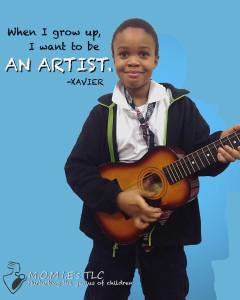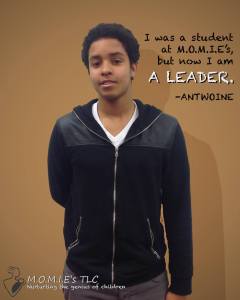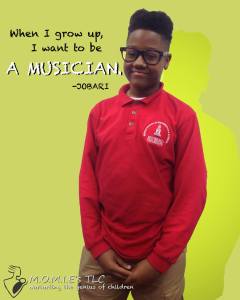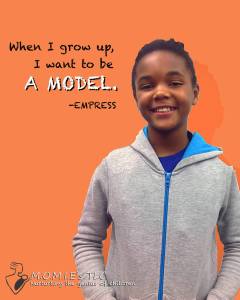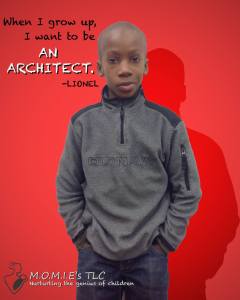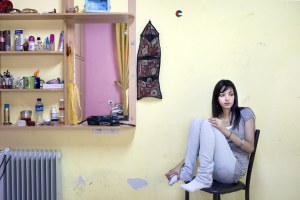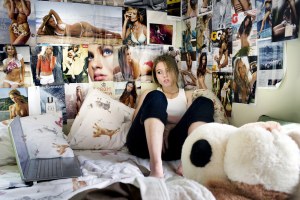Public M.O.M.I.E.S. Group Evaluation
For my final project, I was assigned to the photo series group. I did not know very much about photography before this class, and unfortunately, I cannot say that I know very much more at the end of the project. However, I have learned more about design as our project was much more focused on the design than the actual photos.
Our group’s dynamic was certainly interesting. The five of us all brought something different to the table, which should have made the process seamless. However, with the positive aspects we brought, there were also a few negative aspects that were brought to the table – often from outside sources. For instance, scheduling proved to be one of the most difficult tasks of the entire process as we all had very different lives. Additionally, having the photo series required that we go into MOMIES to take the picture of the children. Once we decided on a day, there was confusion about where we were meeting for it resulting in not everyone being present at MOMIES. While this was not the end of the world, it certainly did not serve to aid our time with MOMIES.
Speaking of our time with MOMIES, Jess and the other leaders were all very accommodating, and while Nora did all the correspondence with them from what I could sense they were prompt and courteous.
I’d say that my role in the group, along with Nora, was to organize and interview. While Kyle was in charge of taking the photos, Wonji and Tomoyo took it upon themselves to do a large chunk of the editing. I suppose I also was the primary presenter when MOMIES came to check up on our work.
I felt our final product was solid. Despite a number of setbacks, we were able to produce a photo series that could be used primarily for advertising. While I do not necessarily see these photos being hung in the space, I do see them being printed out as postcards and distributed to potential donors and I am proud of that.
This project is taxing. There is no other way to describe it. There are many aspects that make this project challenging, but chiefly among them is the fact that it is a group project. I completely understand why this must be a group project, but inevitably there are one or two members who simply do not participate to the level that should be expected of a university student and that is frustrating.
Looking to the future I guess it is difficult to try to fix the universal problem of the “group project” especially when it is so vital to the workload presented here, however, I think that maybe students should be allowed to pick their groups – as we did in the Photo to Life project – to ensure that we all know who we are dealing with. This is not meant to speak ill of my group – I think that my group produced some very good material for an Intro Communications class. It is more just commenting on the practice of blind grouping that is sometimes necessary, but always unfortunate.
Painting to Life Rough Rough Rough Rough Cut
Here is the rough rough rough rough rough rough rough rough cut.
Schedule and Plans for each Member
Pre-Production
No Country for Old Men Remix
My assigned genre was Reality TV Show. There are surprisingly very very very few actual trailers online for reality TV Shows. I found a couple – Utopia and a satirical project – and I borrowed the audio from them to accomplish the narrator and “bugged” victim trope.
I took the concept a little bit darker than I had intended, but the film itself is fairly dark and I couldn’t find nearly enough happy group shots to make a “survivor” esque trailer. So instead, I opted for the “unknowing victim” style of the reality show.
Here is the link:
The password is: VisLit
Storyboard for Group Video
Plot Summary:
Two characters, Joe and Suzy, wake up and do their regular morning routine. Their routines are noticeably similar. They both go to TDR and get a banana, which they proceed to draw on in secrecy. After their drawing is complete they eat the banana, and head off to class. A while later they’re both at Subway and order the same thing, but Joe does not realize because he is distracted. A cut then shows that they are eating their sandwiches next to their laptop, and begin to watch the same movie on Netflix. They continue an almost identical routine, all the way up to going to bed. The next day they are in TDR and both get bananas, and Joe accidentally touches Suzy’s hand. As they exit TDR they walk past each other, refusing eye contact with each other, with their drawn-on bananas in-hand. The shot then fades to “Masks”.
Expected Shot List:
- Panning
- Multi-Layer Action
- Close-Up
- Cross Cut
- Cutaway
- Fill Reveal Frame
- Icon
Scene Deconstruction – The Dark Knight
Widely regarded as one of the best chase sequences in any action film, The Dark Knight boasts some of the most interesting use, and in some cases misuse of common tropes. Beginning here – https://www.youtube.com/watch?v=nCQxhof9RlI, the main sequence begins with a wide, bird’s eye establishing shot of the city giving the audience the scope of the scene. In other words, the establishing shot is testimony to the audience that the upcoming scene will not take place in a single location. The audience is then introduced to the main players of the scene – the Gotham city Police. They provide a good deal of scene exposition as well as spatial exposition with one claiming that “they will be like turkeys on Thanksgiving [down under the main level]”.
With exposition out of the way, the real fun begins for director Christopher Nolan. One of the most hailed rules of cinema is the 180 degree rule. This rule is a basic guideline regarding the on-screen spatial relationship between one character and another character or object within a scene. It grants audiences a quick and simple understanding of where A) the camera is in the scene, B) where the action in the scene is happening. If utilized correctly, the viewer should be able to map out what is happening in their minds. Interestingly, Nolan continuously breaks the 180 degree rule in the tunnel sequence. The different cuts that are spliced together are shots taken from a variety of different angles. The effect is the utter disorientation of the viewing audience as to what is happening throughout the scene. This confusion is ironically a device that should, by the rules definition, disorient the audience and pull them out of the scene, however the breaking of the rule with the Psychopathic Joker running the show only makes the action feel more authentic.
MOMIES Design Reflection – Part 2
This photo series was done by Raina Matar and is entitled A Girl and Her Room. The concept of the series is to highlight the differences in a teenage girl’s room in different developed and developing countries. All of these photos are interestingly taken and at first glance you may not realize they are part of the same series. For instance, all the photos that are taken of rooms belonging to girls in a developed country are highly saturated with color, whereas the rooms that belong to girls in developing countries – that are often more bare – are low in saturation and almost blend the colors together.
My group has decided that we will likely do something akin to the first inspiration I wrote about. We will likely interview a handful of the kids who attend MOMIES on one day, and then come in for a photo shoot another day, bringing in props and costumes to dress them up as what they aspire to be when they are older. The photo’s will then have a little information about who the child is, and maybe one or two memorable quotes from the interview. The feel is meant to be playful, but also convey the hope that each of the children possesses. Stylistically, it will be very different than these photos, however, we can take away from this series the manner in which they highlight the girl, when really the room is the subject of the photo. In that respect, we could play off of highlighting what the child is wearing, by having that appear to be the subject, when really the child is the hope and aspirations of the child is to be at the forefront.
Photography as a Medium
Personally, I put photography on the same plane as dancing. That sounds harsh, and can definitely be interpreted as a dig at photography as a medium or art form, but I do not intend it in that way. What I mean to say is that while I personally do not understand them, or enjoy them, I fully understand that they are valid forms of art and a valid way of presenting ideas and emotions. Photography, more so than dancing, is a particular art form that is deceivingly complex. Obviously, today with our phones that act as computers that are capable of taking any image and enhancing and adjusting it so it is more pleasing it is easy to assume that the act of photographing requires no real skill. I no doubt have that stigma, but I am also incredibly aware that I possess that stigma.
I have always felt that photography was a hobby – you couldn’t really make a successful career out of simply taking a camera around and taking pictures of things people see on the daily. However, after seeing more professional photo galleries through this class, I am starting to understand that while that is essentially what many professional photographers with galleries do, they often do so in a way that highlights the irregularities of the regular. To me, it is similar to Andy Warhol’s classic Campbell’s Soup Can. It is ever so simple that it is open to interpretation in a way that some forms of art are not. For instance, a book is usually a very strict narrative with little room for commentary, or at least the commentary is structured and guided by the story, or plot points. However, with a photograph, often times it is interpreted entirely differently by every single viewer and that is a really interesting, cool thing about the art form of photography.
